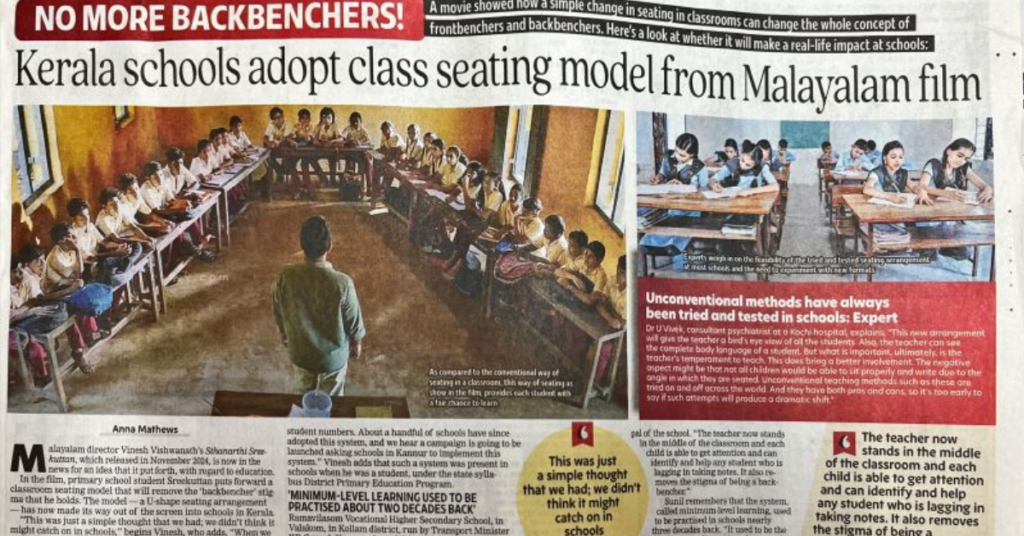
Think back to your own school days. Were you a frontbencher — the one teachers always noticed, who answered questions first? Or did you quietly slip into the back row, out of sight, where the tag of “less interested” often stuck before you even got a chance?
In India, this invisible divide has shaped generations of classrooms. “Frontbenchers” are seen as bright and disciplined, while “backbenchers” are written off as mischievous or disengaged. But what if the problem wasn’t the child — it was the seating itself?
A Quiet Revolution in Kerala
In Kerala, schools are beginning to rethink this divide. Inspired by the Malayalam film Sthanarthi Sreekuttan, some teachers are moving away from rigid rows of benches and instead experimenting with circles, clusters, and flexible layouts.
It may sound like a small adjustment, but for students, the difference can feel huge. When no one is banished to the back, every child is equally visible. When you sit in a circle, your voice carries the same weight as the person next to you. The classroom suddenly feels less like a hierarchy and more like a community.
More Than Furniture
Preethi Vickram, founder of Tapas Progressive Learning, summed it up perfectly: “Classroom seating is a mirror of our teaching philosophies.” For decades, our rows of benches have told children: sit straight, face forward, listen quietly, don’t question too much.
But real learning isn’t a straight line. It happens in debates, laughter, disagreements, and those unexpected questions that make everyone stop and think. When desks are pushed into circles or pods, learning feels alive — not like a one-way broadcast from teacher to student.
The impact goes deeper than comfort. Research shows that seating arrangements affect how students interact, how motivated they feel, and even how much confidence they have to speak up.
A review in Frontiers in Psychology found that flexible seating encourages participation, while traditional rows can unintentionally create a power hierarchy. Those at the front thrive, while those at the back fade into silence.
For a child who has been labeled a “backbencher” all their life, just being placed in the middle of the circle can be transformative. It tells them: you belong here, your ideas count too.
Anyone who’s studied in Indian schools knows how deeply ingrained the seating rules can be. Girls on one side, boys on the other. Toppers up front, “weak students” at the back. The quiet ones are rewarded with proximity to the teacher, while the restless ones are sent farther away.
But what are we teaching when we sort children like this? That some voices deserve to be heard more than others. That intelligence is fixed and visible from a distance. That silence is more valuable than curiosity.
Kerala’s move chips away at these old ideas. By rearranging benches, teachers are also rearranging the very way children see themselves.
And the best part? This change doesn’t need fancy budgets or shiny gadgets. No smartboards, no tablets, no expensive redesign. Just a willingness to move a few benches around.
One circle instead of five rows. A few clusters instead of endless lines. A corner for quiet reading, another for loud debates. That’s all it takes to tell children: “Your voice matters, wherever you sit.”
The word “backbencher” has always carried a stigma in India — sometimes mischievous, sometimes lazy, almost always negative. But maybe those students weren’t uninterested at all. Maybe they were just placed too far away from the conversation.
Kerala’s experiment is showing us that when you break the physical distance, you also break the emotional one. Children once ignored at the back are now speaking up. Those once considered “troublemakers” are participating in group work. And the classroom, instead of being divided, feels whole again.
A Reminder for All of Us
Education reform often feels like a mountain to climb — policies, funding, years of effort. But Kerala’s small shift is a reminder that sometimes, big changes begin with simple, visible steps.
In a world that desperately needs more curious, connected, and creative young minds, we cannot afford to let something as basic as a seating chart hold them back.
So maybe it’s time to ask: in our schools, in our workplaces, even in our own homes — are we still arranging our spaces in ways that silence some voices and amplify others?
Because when every child feels seen, when no one is left at the back, learning stops being a lecture. It becomes what it was always meant to be: a shared conversation.
Also Read: https://scoonews.com/news/maharashtra-education-department-plans-students-tour-to-nasa/
https://thenewstudent.com/wp-admin/post.php?post=4046&action=edit